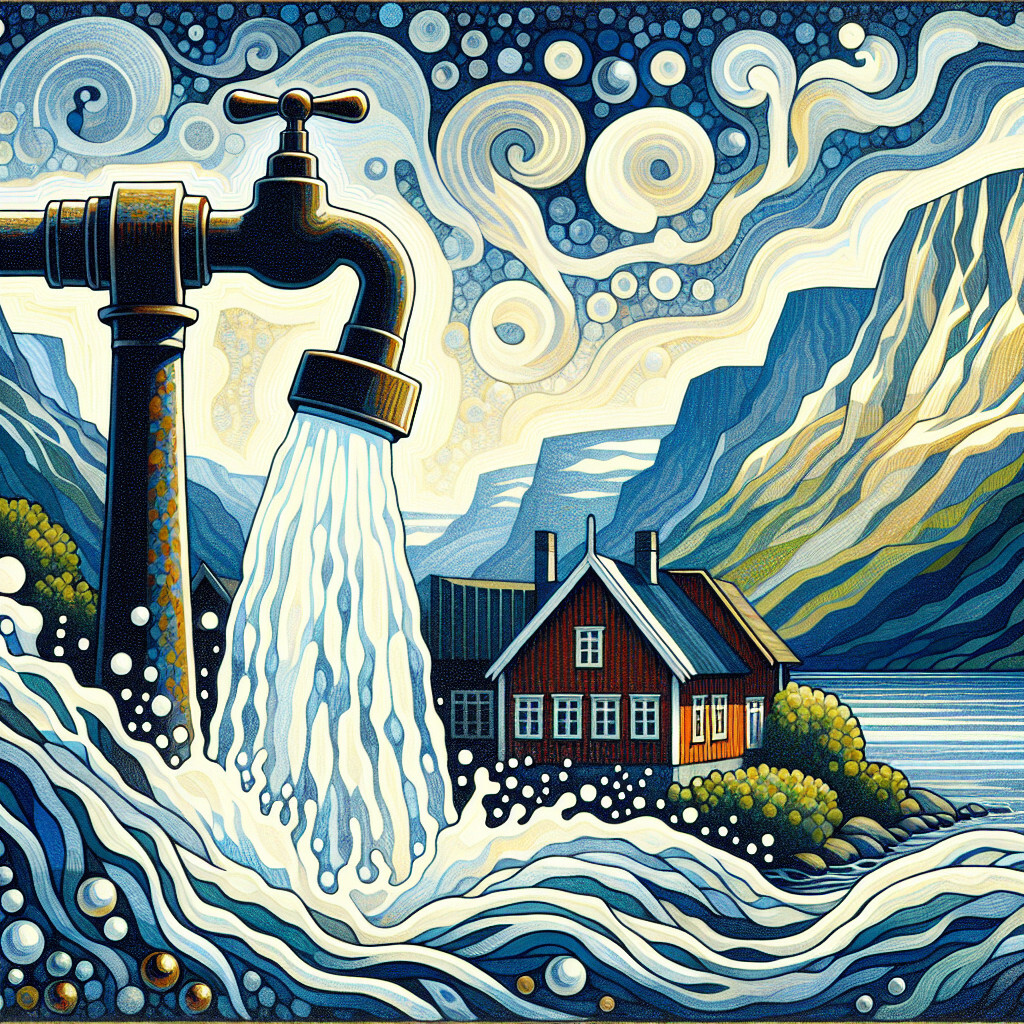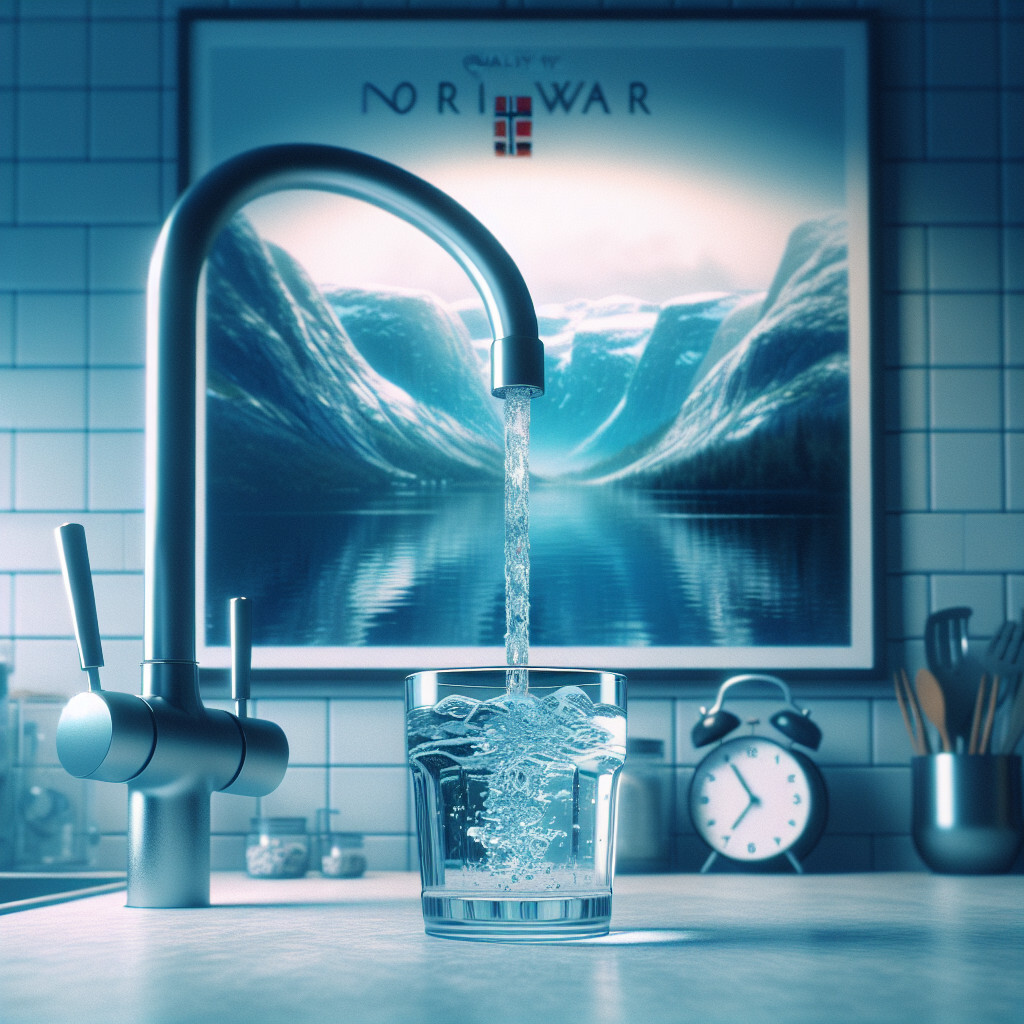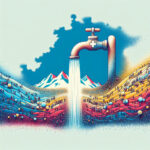-
Table of Contents
“Norway’s Tap Water: Pure, Clean, and Refreshingly Natural.”
Introduction

The tap water in Norway is known for its exceptional quality and freshness. It is sourced from groundwater reserves and natural lakes, undergoing strict quality control measures to ensure it is safe and clean for consumption. The water is typically cold, clear, and has a refreshing taste, often surpassing the quality of bottled water. It is not only safe to drink directly from the tap, but also recommended due to its high purity level.
Understanding the Purity of Tap Water in Norway
Norway, a Scandinavian country known for its breathtaking fjords, northern lights, and rich Viking history, is also renowned for the exceptional quality of its tap water. The tap water in Norway is not only safe to drink but is often considered among the purest in the world. This article aims to provide an understanding of the purity of tap water in Norway, exploring the factors contributing to its high quality and the measures taken to maintain it.
The primary source of tap water in Norway is surface water from lakes and rivers, which is naturally filtered through layers of rock and sand. This natural filtration process removes impurities and contributes to the water’s high quality. Additionally, the country’s low population density and stringent environmental regulations help to minimize pollution, further ensuring the purity of the water.
Norwegian authorities take water quality very seriously. The Norwegian Institute of Public Health and the Norwegian Food Safety Authority work together to monitor and regulate water quality. They conduct regular tests to check for the presence of harmful bacteria, viruses, and chemicals. The results of these tests are publicly available, providing transparency and reassurance to consumers about the safety of their tap water.
Moreover, Norway has a robust water treatment system. While the natural purity of the water often means that minimal treatment is required, any necessary treatment is carried out to the highest standards. The most common form of treatment is disinfection, typically using ultraviolet light or chlorine. These methods effectively kill or inactivate harmful microorganisms, ensuring the water is safe to drink.
The quality of tap water in Norway is so high that bottled water is often seen as an unnecessary luxury. In fact, many Norwegians consider it wasteful to buy bottled water, both in terms of the environmental impact of plastic waste and the financial cost. The tap water is not only safe to drink but is also typically clear, fresh, and free from any unpleasant tastes or odors.
However, it’s worth noting that the quality of tap water can vary slightly from one region to another. In some rural areas, for example, the water may have a slightly different taste due to the natural minerals present. Nevertheless, this does not affect the safety or overall quality of the water.
In conclusion, the tap water in Norway is of exceptionally high quality, thanks to the country’s abundant natural resources, stringent regulations, and effective water treatment processes. It is safe to drink and often surpasses the quality of bottled water. Whether you’re a resident or a visitor, you can confidently drink the tap water in Norway, enjoying not only its purity but also the knowledge that you’re making an environmentally friendly choice.
The Process Behind Norway’s Clean Tap Water
Norway, a Scandinavian country known for its breathtaking fjords, northern lights, and rich Viking history, is also renowned for its exceptionally clean tap water. The tap water in Norway is not only safe to drink but is often of higher quality than bottled water. This is a result of the country’s rigorous water treatment process and stringent regulations, which ensure the water’s purity and safety.
The process behind Norway’s clean tap water begins with the country’s abundant freshwater sources. Norway is blessed with a wealth of natural resources, including vast glaciers, rivers, and lakes, which provide a plentiful supply of freshwater. This water is naturally filtered through layers of rock and sand, which helps to remove impurities and contaminants. However, this natural filtration process is just the beginning of the journey that the water takes before it reaches the taps of Norwegian households.
Once the water is collected from these natural sources, it is transported to water treatment facilities. Here, it undergoes a comprehensive treatment process to ensure its safety and quality. The first step in this process is coagulation, where chemicals are added to the water to bind together small particles into larger clumps, which can then be easily removed. This is followed by sedimentation, where the water is allowed to sit undisturbed so that the heavier particles can settle at the bottom.
The water then goes through a filtration process, where it is passed through layers of sand, gravel, and charcoal to remove any remaining particles. This filtration process also helps to remove any microorganisms that may be present in the water. After filtration, the water is disinfected using chlorine or ultraviolet light to kill any remaining bacteria or viruses. The water is then tested rigorously to ensure it meets the strict quality standards set by the Norwegian Institute of Public Health.
The Norwegian government takes the quality of its tap water very seriously. The country has stringent regulations in place to ensure the safety and quality of its drinking water. These regulations cover everything from the sources of the water to the treatment processes and the infrastructure used to deliver the water to households. Regular testing is carried out to monitor the quality of the water and any issues are addressed promptly to ensure the continued safety of the water supply.
In addition to these regulations, the Norwegian government also invests heavily in its water infrastructure. This includes the maintenance and upgrading of water treatment facilities and pipelines to ensure they are in good working order. This investment ensures that the tap water in Norway remains of high quality and is safe to drink.
The result of this rigorous process and stringent regulations is some of the cleanest tap water in the world. The tap water in Norway is not only safe to drink but is often of higher quality than bottled water. It is clear, tasteless, and odorless, making it a refreshing and healthy choice for hydration.
In conclusion, the tap water in Norway is a testament to the country’s commitment to public health and environmental sustainability. The rigorous process behind its clean tap water, from natural filtration to comprehensive treatment and regular testing, ensures that Norwegians and visitors alike can enjoy safe, high-quality tap water. This, coupled with the country’s stringent regulations and investment in water infrastructure, ensures that Norway’s tap water remains among the cleanest in the world.
Health Implications of Drinking Tap Water in Norway
Norway, a Scandinavian country known for its breathtaking fjords, northern lights, and rich Viking history, is also renowned for its high-quality tap water. The tap water in Norway is not only safe to drink but is also considered among the cleanest and purest in the world. This is due to the country’s stringent water quality regulations and its natural resources, which include abundant freshwater sources from glaciers and rain.
The health implications of drinking tap water in Norway are overwhelmingly positive. The water is free from harmful bacteria, viruses, and parasites that can cause diseases, thanks to the country’s rigorous water treatment processes. Moreover, the water is also low in heavy metals and other contaminants that can pose health risks. This is largely due to Norway’s strict environmental policies and its commitment to preserving its natural resources.
In addition to being safe, the tap water in Norway is also beneficial for health because it contains essential minerals. These include calcium and magnesium, which are necessary for bone health, and potassium, which is important for heart function. The presence of these minerals in the water can contribute to meeting the daily recommended intake, especially for those who consume a lot of water.
Furthermore, drinking tap water in Norway can have indirect health benefits. For instance, it can contribute to reducing plastic waste, as there is no need to buy bottled water. This can have a positive impact on the environment, which in turn can contribute to public health by reducing pollution and its associated health risks.
However, it’s worth noting that the quality of tap water can vary slightly from one region to another in Norway. This is due to differences in the local water sources and treatment processes. For example, in some rural areas, the water may come from small, local sources that are not subject to the same stringent regulations as larger water supplies. Therefore, it’s always a good idea to check with local authorities or your accommodation provider if you’re unsure about the water quality in a specific area.
Despite these minor regional variations, the overall quality of tap water in Norway is exceptionally high. This is reflected in the country’s low rates of waterborne diseases and its high life expectancy, which is among the highest in the world. These health outcomes are a testament to the country’s commitment to providing its residents and visitors with safe, clean water.
In conclusion, the tap water in Norway is not only safe to drink but also has several health benefits. It is free from harmful contaminants, contains essential minerals, and can contribute to environmental sustainability. While there may be slight regional variations in water quality, these are the exception rather than the rule. Therefore, whether you’re a resident or a visitor, you can feel confident about drinking the tap water in Norway.
Environmental Impact of Norway’s Tap Water Management
Norway, a Scandinavian country known for its breathtaking fjords, northern lights, and rich Viking history, is also globally recognized for its exceptional tap water management. The country’s tap water is not only safe to drink but is also considered among the best in the world. This is largely due to Norway’s stringent water management policies and practices, which have significant environmental implications.
Norway’s tap water primarily originates from surface water sources such as lakes and reservoirs, which are naturally filtered through layers of sand and gravel. This natural filtration process, coupled with minimal chemical treatment, ensures that the water retains its fresh taste and high quality. Moreover, the country’s water management system is designed to protect these sources from pollution, thereby preserving the natural ecosystems that depend on them.
The environmental impact of Norway’s tap water management is multifaceted. Firstly, the country’s reliance on natural water sources reduces the need for extensive water treatment processes, which often involve the use of harmful chemicals. By minimizing chemical usage, Norway not only ensures the safety and quality of its tap water but also mitigates the potential environmental harm caused by chemical runoff into water bodies.
Secondly, Norway’s tap water management practices contribute to the reduction of plastic waste. With tap water of such high quality, the demand for bottled water is significantly lower in Norway compared to other countries. This results in less plastic waste being generated, which is beneficial for the environment considering the detrimental effects of plastic pollution on marine life and ecosystems.
Furthermore, the transportation of bottled water requires a considerable amount of energy, which contributes to greenhouse gas emissions. By promoting the consumption of tap water, Norway effectively reduces its carbon footprint, aligning with its commitment to environmental sustainability.
Norway’s tap water management also has a positive impact on the country’s biodiversity. By protecting its water sources from pollution, Norway safeguards the habitats of various species that rely on these ecosystems. This is particularly important in a time when many species are under threat due to habitat destruction and pollution.
However, it is important to note that Norway’s success in tap water management is not without challenges. The country’s water infrastructure is aging, and there is a need for significant investment to ensure its continued efficiency and safety. Climate change also poses a threat, as changes in precipitation patterns could potentially affect the quality and availability of surface water sources.
Despite these challenges, Norway’s approach to tap water management serves as a model for other countries. It demonstrates that it is possible to provide high-quality tap water while minimizing environmental impact. This is achieved through a combination of stringent regulations, careful resource management, and a strong commitment to environmental sustainability.
In conclusion, the tap water in Norway is not only safe and of high quality, but its management also has a positive environmental impact. This is a testament to Norway’s commitment to sustainability and its respect for the natural environment. As the world grapples with the challenges of climate change and environmental degradation, Norway’s approach to tap water management offers valuable lessons in balancing human needs with environmental preservation.
Q&A
1. Question: Is tap water in Norway safe to drink?
Answer: Yes, the tap water in Norway is considered among the safest and cleanest in the world. It is thoroughly tested and regulated to ensure its quality and safety.
2. Question: Does the tap water in Norway taste good?
Answer: Yes, many people find that Norwegian tap water has a fresh and clean taste, as it often comes directly from natural sources like glaciers and lakes.
3. Question: Do I need to boil tap water before drinking in Norway?
Answer: No, tap water in Norway is safe to drink straight from the tap without boiling.
4. Question: Is bottled water better than tap water in Norway?
Answer: Not necessarily. The tap water in Norway is of such high quality that it is often comparable, if not superior, to bottled water. Plus, drinking tap water is more environmentally friendly.
Conclusion
The tap water in Norway is of high quality, extremely clean, and safe to drink. It is considered among the cleanest in the world.






